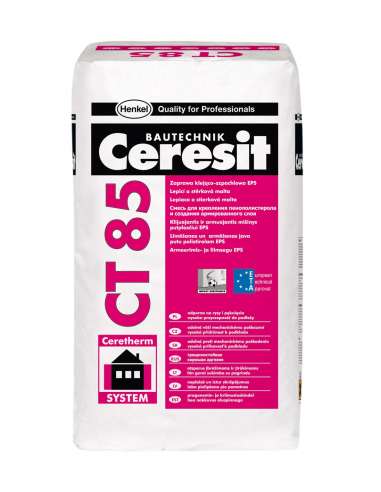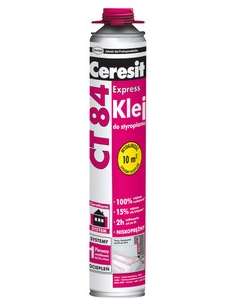- High adhesion to mineral substrates and EPS-boards
- Vapour permeable
- Resistant to weather conditions, hairlines and cracks
- Flexible and reinforced with fibres
- Amount required:
- Fixing of EPS-boards: approx. 5.0 kg/m2
- Reinforced layer: approx. 4.0 kg/m2
CT 85 mortar is designed to warm up external walls of the buildings with the application of a light-wet method and EPS- boards. It is an element within Ceresit Ceretherm Classic and Ceramic Systems. CT 85 mortar is used for fixing EPS-boards as well as applying the reinforced protection layer. Ceresit CT 85 is reinforced with fibres, therefore it is more crack resistant. In case of applying facade mineral wool boards, Ceresit CT 190 mortar should be used.
1. Fixing EPS-boards CT 85 mortar shows good adhesion to carrying, compact and dry substrates, such as surfaces of walls, plasters, mosaics and concretes free from grease, bitumen, dust and other substances decreasing adhesion. The adhesion to the existing plasters and paint coatings should be checked before starting the application. “Hollow” plasters should be removed. Any losses and uneven surfaces of the substrate below 20 mm should be filled with the filler CT 29 or covered with cement plaster. Any surface contaminant and other adhesion impairing substances, steam-tight paint coatings and the coats with low adhesion to the substrate should be completely removed, e.g. by means of washing devices operating under pressure. In case of mycological contamination with fungi, moss and algae, the surface of the facade should be cleaned with steel brushes and, then saturated with a fungicide solution of Ceresit CT 99 in compliance with technical instruction. The old, not plastered walls, strong plasters and paint coats should be dusted, then washed with water jet and left until they go completely dry. Substrates with high water absorption, e.g. walls made of aerated concrete blocks or silicate blocks should be primed with Ceresit CT 17 and left for drying for at least 4 hours. Adhesion of Ceresit CT 85 to the prepared substrate is checked by gluing 10 x 10cm blocks of EPS-boards in a few places and pulling off manually after 4 ÷ 7 days. The load carrying ability of the substrate is sufficient only when the EPS-boards are subject to rent. If EPS-boards tear off with the mortar layer, mechanical anchors should be additionally used.
2. Armoured layer application. When CT 85 is set (after approx. 3 days), the boards should be ground with abrasive paper and additionally fixed with mechanical anchors. If EPS-boards have not been covered with the armoured layer for 2 weeks, then their quality should be evaluated. The yellowed boards with dusting surface should be ground with coarse abrasive paper.
CT 85 should be poured into the measured amount of cool clean water and stirred with the drill by means of a mixer until the homogenous mass is obtained without lumps.
1. Fixing EPS-boards. The ready mortar should be applied with a trowel along the board edges forming a strip of 3÷4 cm wide and a few spots with the diameter of approx. 8 cm. Then immediately, the board should be pressed to the wall with a few slight blows of a long float. The properly applied mortar when pressed should cover minimum 40 % of its surface. In case of even, smooth substrates the mortar should be applied by means of a notched trovel (teeth 10–12 mm). The boards should be fixed tightly one at the other in one surface with the preservation of “brick like manner” of vertical connection.
2. Armoured layer application. The ready mortar of 3÷4 cm-thick layer should be spread along the surface of the boards by means of a smooth long steel float. The glass fibre mesh should be applied on the fresh mortar (with 10-cm overlaps), and then the second 1cm-thick layer should be applied and smoothed evenly so that the glass fibre mesh should not be visible. Fresh stains should be cleaned with water while hardened elements should be mechanically removed.
- Model
- CT85
- Usage/Coverage
- 4.0 - 5.0 kg/sqm
- Size
- 25 kg
- Unit
- bag



